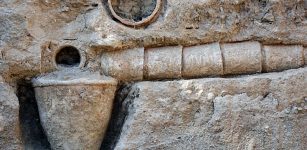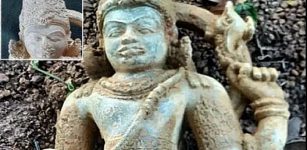New Trove Of Treasures, Funerary Temple, 50 Sarcophagi Unearthed In Saqqara, Cairo
Conny Waters - AncientPages.com - The Egyptian mission working in the Saqqara archaeological site next to the pyramid of King Teti, the first king of the Sixth Dynasty of the Old Kingdom, announced important archaeological discoveries dating back to the old and New Kingdoms.
 A view of the newly discovered tomb of 'Wahtye' which dates from the rule of King Neferirkare Kakai, in the Saqqara area near the necropolis in Giza, Egypt. Image credit: Reuters via Daily Sabah
A view of the newly discovered tomb of 'Wahtye' which dates from the rule of King Neferirkare Kakai, in the Saqqara area near the necropolis in Giza, Egypt. Image credit: Reuters via Daily Sabah
Among them are:
- the discovery of the funerary temple of Queen Nearit, the wife of King Teti
- The discovery of burial wells, coffins, and mummies dating back to the New Kingdom 3000 BC
- Discovery of a 4-meter-long papyrus containing the texts of Chapter 17 of the Book of the Dead
- Discovery of statues, stelae, toys, wooden boats, and funerary masks that date back to the New Kingdom
The mission is led by Dr. Zahi Hawass, who works in cooperation with the Ministry of Antiquities and through Bibliotheca Alexandrina.
The discoveries will influence the history of this region, especially during the 18th and 19th dynasties of the New Kingdom, during which King Teti was worshiped, and the citizens at that time were buried around his pyramid. The mission confirmed that the entrance to the Saqqara region in the New Kingdom was through this area, according to the Ministry of Antiquities of Egypt.
Archaeologists unearthed the funerary temple of Queen Nearit, the wife of King Teti, part of which was already uncovered in the years prior.
 Today are called "shabtis" figurines. Image credit: Ministry of State of Antiquities
Today are called "shabtis" figurines. Image credit: Ministry of State of Antiquities
The mission discovered the layout of the temple in which the queen’s tomb was being revived, and the mission also found within the temple three mud-brick warehouses attached to the temple in the southeastern side - these stores were built to store temple provisions, offerings, and tools that were used in the queen’s tomb.
Among the most important discoveries of the mission also at the site was the unveiling of 52 burial shafts, that reach 10-12 meters deep, and inside these shafts, hundreds of wooden coffins dating back to the New Kingdom were uncovered.
This is the first time that coffins dating back 3,000 years have been found in the Saqqara region.
These coffins are wooden and anthropoid, and are many scenes of the gods that were worshiped during this period were represented on the surface of the coffins, in addition to various excerpts from the Book of the Dead that help the deceased to pass through the journey of the other world. Indeed, as well as in the modern state. The discovery confirmed that the Saqqara area was not used for burial during the Late Period only, but also during the New Kingdom.
 A trove of ancient coffins and artifacts on display that Egyptian archaeologist Zahi Hawass and his team unearthed in a vast necropolis, in Saqqara, south of Cairo, Egypt, Sunday, Jan. 17, 2021. (AP Photo/Nariman El-Mofty)
A trove of ancient coffins and artifacts on display that Egyptian archaeologist Zahi Hawass and his team unearthed in a vast necropolis, in Saqqara, south of Cairo, Egypt, Sunday, Jan. 17, 2021. (AP Photo/Nariman El-Mofty)
The mission also succeeded in discovering a cache of anthropoid wooden coffins. Inside this shaft, 50 coffins were found in good condition.
The mission uncovered a luxurious mud-brick shrine dating back to the New Kingdom, it reaches to a depth of 24m below the ground level without hitting the burial chamber yet.
The open court of the shaft was paved with well-polished and shiny limestone slabs, and this is the first time that a shaft with this depth has been found, and work is still in progress, and Dr. Zahi Hawass believes that this shaft was not looted by thieves, and it will be fully disclosed.
The discoveries found in the shaft are considered one of the most important findings uncovered in the Saqqara region, and date back to the New Kingdom.
 Image credit: Ministry of State of Antiquities
Image credit: Ministry of State of Antiquities
This discovery confirmed the existence of many workshops that produced these coffins, which were bought by the locals, as well as mummification workshops.
Inside the shafts, the mission discovered large numbers of archaeological artifacts and a large number of statues that represents deities such as the god Osiris and Ptah-Sokar-Osiris, in addition to a unique discovery, where the mission found a papyrus, whose length reached four meters in length and one meter in width, representing Chapter 17 from the Book of the Dead, and the name of its owner is recorded on it (Pw-Kha-Ef). The same name was found on four shabty statues, and on an anthropoid wooden coffin.
Many beautiful shabty statues made of wood, stone, and faience have been found dating back to the New Kingdom.
 Image credit: Ministry of State of Antiquities
Image credit: Ministry of State of Antiquities
The mission also found many wooden funerary masks as well as a shrine dedicated to god Anubis (Guardian of the Cemetery) and beautiful statues of Anubis, as well as many games that the deceased used to play in the other world, such as the game (Senet), which is similar to the modern chess. as well as the (Twenty) game with the name of the player recorded. Many artifacts were found that represent birds such as geese, as well as a magnificent bronze ax, indicating that its owner was one of the army leaders during the New Kingdom.
A wonderful well preserved limestone stelae was found in one of the excavated shafts, it belongs to a man named Kha-Ptah and his wife Mwt-em-wia.
The upper part of the stelae represents the deceased and his wife in an adoration gesture in front of god Osiris, while the lower part represents the deceased sitting and behind him his wife seated on a chair. Below the chair of the wife there is one of their daughters sitting on her legs and smelling the lotus flower, and above her head is the ointment flask.
In front of the man and his wife we see six of their daughters and sons, who were depicted in two registers, the upper one for seated daughters smelling the lotus flowers and above their heads are the ointment flasks, and the lower one for standing sons.
 Image credit: Ministry of State of Antiquities
Image credit: Ministry of State of Antiquities
The thing that grabs our attention that one of their daughters bear the name Nefertary, named after the beloved wife of king Ramesses II, who built her a marvelous tomb at Valley of the Queens as well as a temple at Abu Simbel.
In addition to that, one of his sons was names Kha-em-waset, named after one of the sons of King Ramesses II, and he is considered a wise man, and known as the first Egyptologist, who used to restore the antiquities of his ancestors.
As for the titles of the owner of the stela, he was the overseer of the king’s military chariot, which indicates his prestigious position during the 19th Dynasty.
The mission also found impressive quantities of pottery dating back to the New Kingdom, including pottery that gives us evidence about the commercial relations between Egypt and Crete, Syria, Palestine.
Dr. Sahar Selim, a professor of radiology at Qasr al-Aini, conducted studies on mummies using X-ray, and determined the causes of death and the age of the deceased on death, as well as studying a mummy for a young child.
The mission studied the mummy of a woman and determined that this woman suffered from a chronic disease known as "Mediterranean fever" or "swine fever", a disease that comes from direct contact with animals and leads to an abscess in the liver.
Dr. Zahi Hawass confirms that this discovery is considered the most important archaeological discovery during the current year and will make Saqqara, along with other discoveries, an important tourist and cultural destination. It will also rewrite the history of Saqqara during the New Kingdom, in addition to confirming the importance of the worship of King Teti during the 19th Dynasty of the New Kingdom.
Written by Conny Waters - AncientPages.com Staff Writer




















